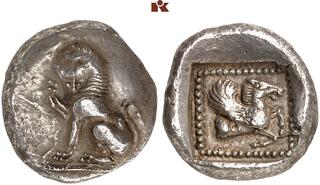| Fritz Rudolf Künker GmbH & Co. KG > Auction 402 | Auction date: 14 March 2024 |
| Lot number: 43 Price realized: 7,000 EUR (Approx. 7,622 USD) Note: Prices do not include buyer's fees. | Show similar lots on CoinArchives Find similar lots in upcoming auctions on |
| Lot description: LYCIA. Prä- und protodynastische Prägungen. Unbestimmter Dynast AR-Stater, um 480 v. Chr., unbestimmte Münzstätte; 9,31 g. Löwe sitzt l. mit erhobener Pranke//In Incusum: Perlquadrat, darin Pegasosprotome r. Müseler III, 26 (dies Exemplar). R Feine Tönung, Prägeschwächen, vorzüglich Exemplar der Auktion Bank Leu 7, Zürich 1973, Nr. 249 und der Auktion Leu Numismatik 76, Zürich 1999, Nr.201. Das geflügelte Pferd Pegasos war ursprünglich der blitztragende Begleiter des luwischen Wettergottes Pi?aššašši (vgl. Hutter 1995). Die Griechen verformten seinen Namen in Pegasos und verstanden ihn dann als Quellpferd (abgeleitet von gr. pegé/Quelle). Mit seinem Huf brachte es Quellen zum Sprudeln, unter anderem auf dem Musenberg Helikon. So wurde der Pegasos zum Musen- und Dichterpferd, das heute im Giebel mancher Theater zusammen mit Apollon und den Musen dargestellt ist. Das Vorkommen des Pegasos in Lykien ist besonders interessant, weil Bellerophon auf dem Pegasos das lykische Ungeheuer Chimaira besiegt haben soll, vgl. Raimond 2017, 47: "On peut ainsi considérer le Pégase hésiodique comme une interpretatio graeca d'une tradition louvite; le cheval ailé, porteur de l'éclair de Zeus peut alors être rapproché du dieu de l'Orage Pi?assassi adoré aux IIe et Ier millénaires av. J.-C. Selon M. Hutter, il ne serait pas seulement le souvenir d'un dieu de l'Orage, mais l'adaptation concrète du "dieu de l'Orage de l'éclair" construite dans le context lycien de la geste de Bellérophon". Angesichts der Vermischung kleinasiatischer und griechischer Traditionen in Lykien lässt sich nicht ermitteln, woran die lykischen Münzherren dachten, wenn sie sich für eine Darstellung des Pegasos entschieden. [JN] The winged horse Pegasos was originally the lightning-carrying companion of the Luwian weather god Pi?aššašši (cf. Hutter 1995). The Greeks changed his name to Pegasos and then understood him as a horse that could knock a spring out of the ground with its hoof (its name was derived from the Greek pegé/spring). One of these springs was the Hippokrene/Horse spring on the Muses' mountain Helikon. Therefore, Pegasus became the horse of the Muses and poets and is thus depicted in the pediments of many modern theatres together with Apollo and the Muses. The occurrence of the Pegasus in Lycia is particularly interesting because Bellerophon riding on the Pegasus is said to have defeated the Lycian monster Chimaira, cf. Raimond 2017, 47 (transl. by J. Nollé): "The Hesiodic Pegasus can thus be seen as an interpretatio Graeca of a Louvite tradition; the winged horse, the bearer of Zeus' lightning bolt, can then be compared with the storm god Pi?assassi worshipped in the 2nd and 1st millennia BC. According to M. Hutter, it would not just be the memory of a storm god, but the concrete adaptation of the "storm god of lightning" constructed in the Lycian context of Bellerophon's heroic feat. In view of the mixture of Asia Minor and Greek traditions in Lycia, it is not possible to determine what the Lycian coin authorities were thinking of when they decided for a depiction of Pegasus." [JN] Estimate: 1250 EUR |  |



